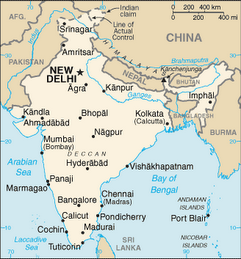
This weekend we took the arduous, but worthwile, trip to Varanasi, India. Varanasi is the holiest city in India, and purportedly the second-holiest city in the world, second only to Jerusulem. It is an ancient city on the Western banks of the Ganges, and one of the greatest pilgrimage points on earth. Near Allahabad, at the sangum of the Yamuna and Ganges, the river plane of Uttar Pradesh in Northern India is one of the most crowded regions on earth, and believe me, it feels like it.
Varanasi is, to say the least, a city of extremes. As articulated by Greg, "Varanasi is India in a crucible." It is the incarnation of so many thoughts, expectations, stereotypes, cliches, and extremes. Innumerable adjectives could be used to describe the experience of journeying to Varanasi... overwhelming, powerful, incredible, uncomfortable, holy... the latter perhaps most poignant, altered, though not necessarily diminished, by the innumerable former...
When you arrive in Varanasi it's like any other Indian experience; your flight is inevitably 3-hours delayed, you stumble off your budget airline perturbed, but at least well-fed by veg food and square bottles of water, and you chart your exit from the terminal. Through the sea of eyes, crumpled name cards, and tan-clad security forces nonchalantly bearing weapons, you plot your course and walk decisively, brushing aside offers and "deals" that abound.
Varanasi was all this, but maximized on arrival, and compounded as soon as we began to enter the city. A 12-kilometer drive from the airport took us 90 minutes, and involved one minor accident of a motorbike clipping our bumper... an amazingly low rate given the magnitude and proximity of traffic. While, at a size of 1 million people Varanasi is as large as San Diego, it lacks even a modicum of proper infrastructure. Save for roads, which are paved, the city is impoverished to an extreme, more crowded than Bombay, and host to the putrid scents that I'm starting to associate as common. Scores of people walk amidst water buffalo, pooled water, and feril dogs. A wild boar stands aside a goat next to a man mixing concrete for a building construction staffed by a dozen employed, but idle workers. Trash cans do not exist. Bathrooms abound, and despite the diversity of life on the streets, the smell is quite similar. The smell also eminates from the lapping water of the Ganges, the river in which offerings are made, men and women bathe and brush teeth, and the ashes of the dead are spread.
A walk along the Ghats (steps) of the Ganges involves an uncomfortable but rewarding confluence of sights, smells, thoughts. Holy men in saffron, men who have denounced worldly possessions, stand in reverence aside the holy Ganges, partaking in puja, offering prasad, uttering words in Hindi with eyes closed. Twenty men build a small boat while children scamper to sell you a candle and flowers to offer the Ganga at sundown. Women beat clothes into cleanliness in water sullied by a million pollutants. Others swish the same water and toothpaste to purge their rotting red teeth of the betelnut-stain. And still other men, naked, or wearing only loin cloths perch in tents nursing fire and applying gray ash to their skin. Their hair is madded and made wiry by time spent resolutely devoted to their cause.
Further down the Ganges are more naked, ash-covered men, others in saffron, others self-mutilated into forms a boy explained to us as "in the form of Ganesh." Ganesh, the god of beginnings and good fortune, has the head of an elephant. One man atop the ghats too had one eye, and half of his face loosely hanging in a flap of skin vaguely reminiscent of a trunk. Again, I cannot fully comprehend, but I can appreciate the experience as an eye-opening look at religious devotion.
Our final stop along the ghats was at the "Burning Ghats." When men and women are prepared to die, many Hindu devotees will make the trek to the Ganges for cremation and final resting in the Ganges. It is believed that the holy river can absolve one of sins, and allow one entrance into heaven. At the burning ghats there are hospice houses. There are piles and piles of wood. There is banyan, mango, and sandalwood. There are pyres. There are colored linens that vaguely resemble human forms. There is one eternal flame from which all cremation ceremonies begin. Though there is undoubtedly sadness, there is reverence and there is also no crying. There is no smell but that of wood. There are a dozen fires on different terraces alluding to the status of the individual. There is silence, save for the lapping water of the Ganges, the occasional crackle of the flames, and the communal hush of respectful onlookers engaged in a timeless Hindu tradition on the bank of the Ganga.
Varanasi, while tiresome, culturally daunting and immensely crowded, retains a holiness that transgresses the squalor and saddness that are the brethren of poverty. And that experience is sufficient enough to visit, though perhaps not return.



No comments:
Post a Comment